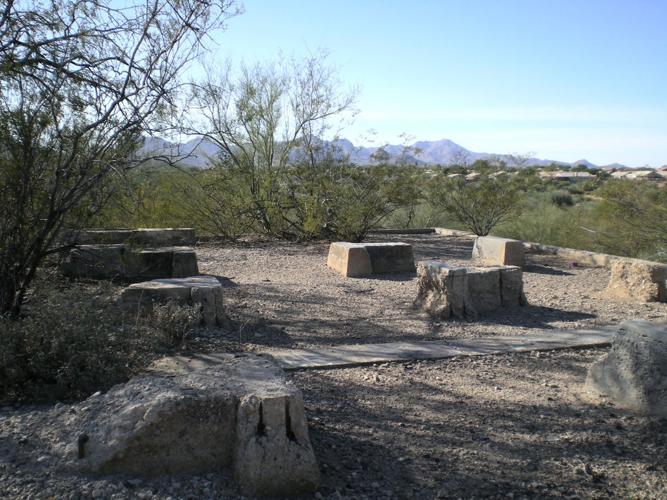Defense has played an important part in the history of Tucson.
From the Hohokam rock fortifications atop the peaks of the Tucson Mountains and Cold War-era Titan missiles to Davis-Monthan Air Force Base and Raytheon today, this region has a well-recorded reputation in the age of armed conflict.
However, in some cases there is scant history regarding Tucson’s defense industry. The Tungsten Ore Mill site is a prime example of a wartime ore-processing facility whose history remains unknown to most Tucsonans.
The remains of the ore mill are located near Anklam Wash northwest of the intersection of North Silverbell Road and West Speedway in the foothills of the Tucson Mountains. The mill played an important role in supplying the allies with tungsten during World War II.
Tungsten is a metallic element that has a variety of uses ranging from a hardener of steel for armor and the nose cones of rockets to a variety of electrical applications such as lamp filaments and television tubes. It has the highest melting point of metals at 6,170 degrees Fahrenheit (3,410 Celsius), which enables the filament of light bulbs to burn without melting.
The tungsten processed at this site came from an undisclosed location. Although not mined in the Tucson Mountains, the tungsten might have been mined in the Huachuca Mountains, the Little Dragoon Mountains and the northern Santa Catalina Mountains around Campo Bonito.
The purpose of the ore mill was to extract metals from rock mined beneath the earth. Crushed and separated from the metal by grinding and stamp milling machinery, the ore was mixed with water and chemicals (cyanide and mercury) in settling tanks. The heavier metal sank to the bottom of the tanks and was extracted.
Afterwards, the processed ore was shipped by rail under armed guard from Tucson to Kansas City to aid in the war effort.
The origin of the ore mill remains shrouded in mystery, but it probably dates back to the early 1940s.
Arthur Jacobs, a prominent Tucsonan whose family had been in the assay business since the 1880s, was contracted by the Defense Department to build and use the mill to process tungsten.
The mill’s operation is presumed classified by the military since no documention has surfaced about when the mill was in operation or the amount of ore it processed. Its existence was never listed in the local directories. Aerial photography taken since World War II has provided no identifying marks of how the structures originally appeared.
The ore mill may have ceased operations as the availability of more economical sources of tungsten became available in Europe at the conclusion of the war. Today, all that remains of the mill are concrete piers and slabs, equipment mounts, graffiti-strewn masonry walls, sherds of broken glass, rusted metal pipe and slag. A firebrick embossed with three stars was recently discovered at the ore mill, probably belonging to one of the kilns that operated at the site.
The city of Tucson owns the 30-acre parcel of land that includes the ore mill. Signs on a metal fence warn of potential environmental hazards at the site.
In 2007, the U.S. Environmental Protection Agency awarded the city of Tucson $200,000 to clean up the toxic metals — including arsenic, cadmium and lead — remaining in the ground at the site.
Future planning by the city’s Parks and Recreation Department for the vacant lot of land includes a park that would have interpretive-walking trails, benches and scenic overlooks.
There is also an attempt to determine whether the mill foundations are eligible for National Register of Historic Places status.





